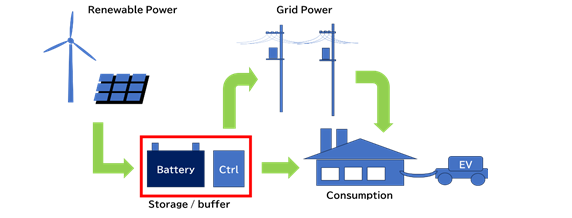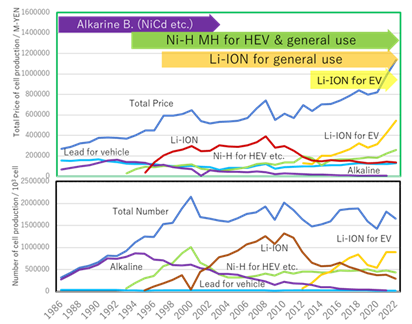The Role of Rechargeable Batteries in Increasing the Use of Renewable Energy ~The Importance of Increased Production and Cost decreasing~
11/12023
Author: Haru-Hisa Uchida
Automobiles that use combustion engines burning fossil fuels have now been replaced rapidly by EV world widely. This may also be a trend toward electrification of all things, not just automobiles.
It is well understood that renewable energies, such as wind and solar power, are characterized by their almost inexhaustible supply and low environmental impact. However, their "disadvantages," such as low energy density (A typical thermal power plant has an output capacity of approximately 1 million kW. If same amount of power is to be generated by solar cells, the entire Tokyo metropolitan area, inside area of the Yamanote-Line (approximately 63 km2), would have to be covered with solar cells (assuming 0.6 kW/m2 of sunlight, 6 hours/day of sunlight, 20% conversion efficiency, 50% sunny rate)) and lack of stability, may not be fully understood. For example, in the case of electricity, the system infrastructure is constructed with intensive electricity production at one location (power plant) and distribution to consumption areas through grid networks. Electric companies have been established systems with high quality and stable supply now.
Attempting to connect renewable energy directly to this system would create a contradiction, as it would degrade quality and therefore would not be able to accept more than a certain amount of electric power. This creates a situation sometimes where drastic amount of renewable energy is discarded.
If the renewable energy is to be connected to the conventional grid and used more effectively, a buffer is absolutely needed: once stored, aggregated, and released on demand. While it is also possible to convert electricity to hydrogen media, but we will focus on the more familiar form of electricity in this collum.
In an electric power system, the buffer would be rechargeable batteries(Fig.1). While there are multiple ways to store electricity, including pumped storage and others, rechargeable batteries are the easiest to use, regardless of the size of the system.

If we must use more power from renewable energy sources effectively, we must increase earlier the production and supply of rechargeable batteries.
Since around 2012, the production of lithium-ion batteries for car loading has been in full swing, indicating that the cost of battery sales is also increasing (Fig.2). Because the difficulty of extreme large-scale form of each lithium-ion battery, the number of cell produced can be viewed roughly as the capacity of their widespread use.

Recently, large-scale production of solid type lithium-ion batteries has begun. Further increases in production for automotive use will drive lower costs and increase the overall charge capacity of the batteries, which will also drive their use in various purposes besides automobiles, leading to the use of renewable energy. A concern such as the rising cost of lithium mineral resources will become even greater in the future, we need to hurry further increase of production volume of rechargeable batteries, along with the maturation and expansion of recycling technology and the development of batteries using a variety of materials.
